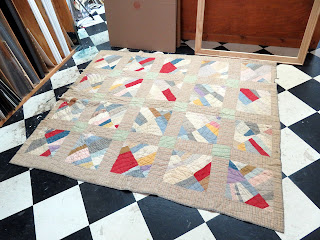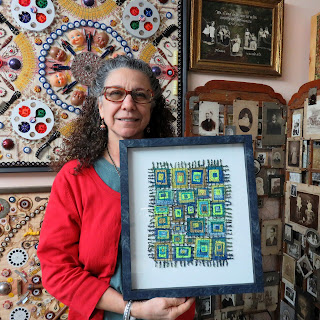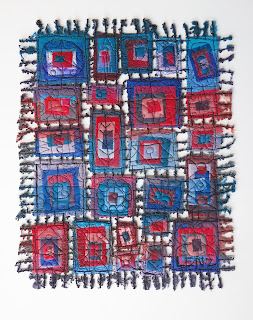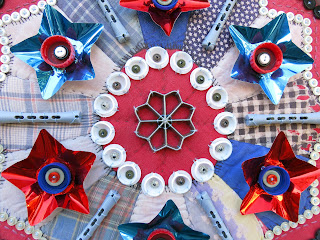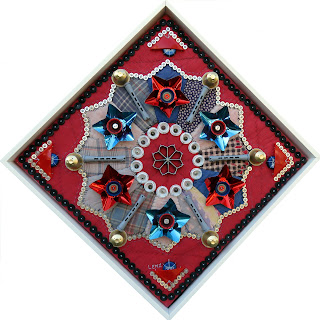(Above:
Mandala CV. Custom framed: 22" x 22" when hung as a square; 31 1/4" x 31 1/4" when hung as a diamond. Found objects hand-stitched to a large, vintage quilt block. Found objects include: Steinway piano parts; decorative, brass plates for drawer pulls; keys; coffee K-pods; tan, plastic bottle caps; faux-coin bangles; a silver coaster; a gold Christmas light reflector; a black beer bottle cap; and buttons. Click on any image to enlarge.)
Months and months ago, I had a solo show at Central Piedmont Community College. Several of my Found Object Mandalas were included. During the weeks of this exhibit, the nearby Carolina Steinway dealership visited. They were negotiating a new, grand Steinway for the new, grand arts building that was under construction. They saw that I'd stitched a few felt-covered piano hammers on some of the pieces. They liked what they saw but didn't make a purchase. After all, they'd rather the piano parts came from a Steinway. They contacted me and initiated an amazing adventure!
(Above: Mandala CVI. Custom framed: 22 1/2" x 22 1/2" when hung as a square; 31 3/4" x 31 3/4" when hung as a diamond. Found objects hand-stitched to a large, vintage quilt block. Found objects include: Steinway piano parts; soups spoons; keys; coffee K-pods; a glass floral frog; four brown rings of unknown function; and buttons.)
I couldn't create a "Steinway" Found Object Mandala without first having an old Steinway! At the time, I couldn't imagine anyone getting rid of a Steinway! Seriously, it's a STEINWAY. Little did I know that pianos, even Steinways, aren't like 17th and 18th century Stradivarius stringed instruments. Pianos aren't easily taken apart, carefully glued back together, re-varnished, re-strung, and played by the world's most gifted musicians. Once the sound box is cracked or otherwise broken, repairs are more costly than a new instrument. Repaired Steinways aren't necessarily "better" than a new one or even as good as they originally were. So the dealership found an old, upright Steinway that had no better future than having its parts find a "second life" in my artwork.
(Above: Me ... in the process of dismantling an upright Steinway inside the cargo van.)
It took two men lifting and me pushing from the back to get the piano into my cargo van.
Dismantling the Steinway went well until we could find no more screws.
Apparently, the sides and a couple other wooden parts are pegged and glued. A google search told us to "use a sledge hammer". It seemed CRAZY but one little tap and it worked! We are still trying to find a woodworker who wants the nice, mahogany wood. We have taken the "harp" (the part to which all the metal wires are attached ... which produces the music) to another artist. We aren't sure what will happen with this heavy, cast iron piece ... but hopefully it will become something "interactive" for the public.
(Above: Detail of
Mandala CV.)
For me, only the small, internal parts are most easily incorporated. On Mandala CV, I used three different parts without cutting them apart. Each individual key/note had these three parts. I only had room for seven groups. Obviously, I have lots of them left!
(Above: Detail of Mandala CVI.)
For Mandala CVI, I cut the felt covered hammers off the rest of their part and combined them with two other parts. I really don't know the names of these parts ... despite having once spent hours in the Smithsonian's Dillon Ripley Center when Piano 300: Celebrating Three Centuries of People and Pianos was on view. (March 2000 - October 2001). It was a great show. Yes, there was a Steinway or two. I learned to appreciate this complicated instrument but not the names of the parts! Anyway, Steinway's signature colors are black, white, and Old World gold. Unfortunately, most of the parts of a Steinway aren't actually black, white, or gold. The large, vintage quilt block is about as close as it can get!
My agreement with the Carolina Steinway dealership was to create a couple Found Object Mandalas and to give them "first refusal". This means, these two pieces will be offered to them first. They are under no obligation to buy either. These two pieces will remain on "first refusal" for the coming weeks. Why? Well, I am also creating another "Steinway Mandala". It will include all eight-eight keys ... the entire key ... which is a lot longer than what is seen when playing the piano. I'm very excited about this. It is going to be really, really BIG. By the way, this old upright was a much older piano; its white keys are real ivory!



